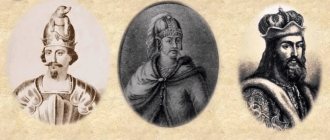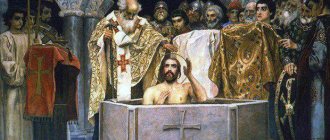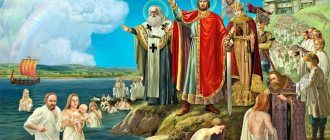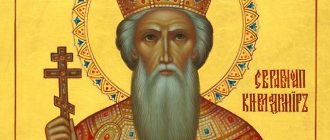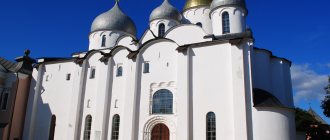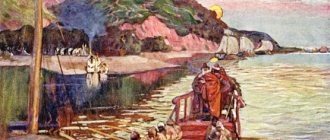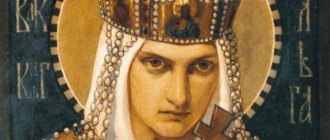Russian history. Prince Vladimir the Saint. All about Prince Vladimir.
A unique weight loss program from Faberlic. New faberlic cosmetics on faberllena.ru
All about Prince Vladimir.
Years of reign: 980 - 1015.
Vladimir is the son of Svyatoslav, his mother is Malusha, housekeeper-slave of Princess Olga, concubine of Svyatoslav.
Came to power as a result of victory in the first feudal struggle between the sons of Prince Svyatoslav: Vladimir, Yaropolk and Oleg.
During his reign, the process of forming the state of Kievan Rus was completed.
Domestic policy.
- Further strengthening of the Old Russian state:
- 980 - the first religious reform , pagan reform, proclamation of Perun as the supreme deity was carried out;
- 988 - adoption of Christianity , strengthening of the power of the prince under the name of the one God. The Church has become a huge force uniting the people;
- 988 - completion of administrative reform : Vladimir appointed his sons to governors and to cities;
- carrying out judicial reform , adopting the “Zemlyanoy Charter” - a set of norms of oral customary (from the word “customs”) law;
- carrying out military reform: instead of Varangian mercenaries, the prince is served by “the best men” from the Slavs; Vladimir fortified the southern borders with the “Serpentine Ramparts” - a solid wall made of an earthen embankment, earthen trenches, and outposts.
- Expansion of the territory of Rus':
- annexation of new East Slavic tribes: the Vyatichi in 981-982, the Radimichi and Croats in 984.
- Construction of new cities, strengthening and decoration of the capital:
- a new fortress was built in Kyiv, the city was fortified with earthen ramparts, and decorated with architectural structures;
— cities were built: Belgorod, Pereyaslavl, Vladimir-Klyazma and others.
- Development of culture.
- creation of the Slavic alphabet by the enlighteners Cyril and Methodius;
- translation of books from Greek, the beginning of the spread of literacy;
- introduction of a special tax for the development of culture and architecture - tithe . In 986-989 the first church was built - Tithe (Assumption of the Virgin Mary)
- development of icon painting, as well as fresco painting - images on wet plaster.
- the beginning of large-scale stone construction.
Foreign policy.
The main directions are the fight against the Pechenegs, wars with Poland and Hungary.
- Strengthening the international authority of Rus':
— with the adoption of Christianity, the country was no longer considered barbaric and began to be perceived as a civilized state;
— Vladimir introduced dynastic marriages; he himself was married to the sister of the Byzantine emperor, Anna.
Military clashes and peace negotiations with foreign countries:
- fighting the Pechenegs;
- conquest of the Principality of Polotsk;
- trip to Volga Bulgaria;
- 981 - the first clashes with Poland over the border Cherven Rus - Cherven and Przemysl were captured;
- 985 – campaign against Danube Bulgaria and a peace treaty with it;
- 985 - campaigns against Volga Bulgaria , as well as the imposition of tribute to Khazaria;
- 988 - 989 - siege of Korsun (Cherssones) in Crimea;
- 991 - campaign in the Dniester lands against the White Croats;
- Pecheneg raids : 990, 992 - on Peryaeslavl, 996 - battle of Vasilyevo, 997 - Pecheneg attack on Kiev; construction in the south - a solid wall (picket) on an earthen embankment - Serpentine Shafts.
— diplomatic contacts with countries: ambassadors of the Pope came to Kyiv, the Russian embassy went to Germany, Rome. Peace treaties with the Czech Republic, Byzantium, Hungary, Poland.
Acceptance of Christianity.
Reasons for accepting Christianity:
- the need to ensure a stronger unification of tribes on the basis of a single ideology - religion;
- the adoption of a monotheistic religion (that is, belief in one God) strengthened the authority of the ruling stratum and the ruler;
- social inequality also required the emergence of a new ideology in order to justify the rich and somehow console the poor with the hope of a happy life in paradise, that is, the justification of inequality;
- the new religion would expand the cultural influence of more developed countries, especially Byzantium.
- the need to increase the international authority of Rus': the opportunity arose to enter into political alliances with other countries through dynastic marriages. In addition, Rus' would no longer be considered a barbaric, pagan country.
The meaning of accepting Christianity:
- strengthening the power of the prince;
- The church began to play a major role in the country, uniting the people and strengthening the princely power;
- development of culture, writing, education; the emergence of Christian laws - do not kill, do not steal and many others that contributed to the formation of moral principles;
- however, Christianity contributed to increased exploitation by condemning protests, persecuting dissidents;
- the growing international authority of Rus', Rus' achieved equality with other Christian countries, and dynastic marriages became possible.
The significance of the reign of Vladimir the Saint.
- Significant strengthening of the power of the Grand Duke with the adoption of a single religion.
- The beginning of the formation of a unified ideology.
- Completion of the process of forming the state territory of Rus' - all East Slavic lands were annexed.
- The final establishment of a ladder system of transfer of power, that is, to the eldest in the princely family.
- Creation of a system of defensive structures and fortresses on the southern borders.
- Significant cultural development.
- Strengthening the international authority of Rus'.
Some interesting facts about the activities of Prince Vladimir.
- Under Vladimir, many kilometers of defensive lines were built around Kyiv. They were called “Serpentine Ramparts” because, according to legend, battles of Russian heroes with a huge serpent, which became a habit of the Slavic lands, took place here. Watchtowers were also erected here . If the enemy approached Kyiv, then signal lights were lit - this was how they reported the approach of the enemy.
- Vladimir carried out a pagan reform in 980. 6 gods were left: Perun - the god of war and thunderstorms, Khors - the god of sunlight, Simargl - the god of the underworld, Stribog - the god of the wind, Dazhbog - the god of fertility and light, Makosh - the goddess of fertility and patroness of the clan .
- An interesting fact is the adoption of Christianity. Vladimir decided to marry the Byzantine princess Anna, the sister of Emperor Vasily II. But he was against the marriage, since Vladimir was the illegitimate son of Svyatoslav and the housekeeper slave Maklushi. According to the agreement, Prince Vladimir undertook to help Vasily suppress the rebellion - after which the wedding was to take place. The emperor did not fulfill his promise. Then the prince captured the stronghold of Byzantium - the city of Chersonesos (Korsun). The Emperor agreed to the marriage, but on the condition that Vladimir accepted Christianity.
- The baptism of Rus' was very difficult. People did not want to forget their gods, whom their ancestors worshiped. Novgorod especially rebelled. He was baptized “with fire and sword”: Putyata (Kiev thousand) - with a sword, and Dobrynya (Vladimir’s uncle, governor in Novgorod) - with fire, when he and his soldiers set fire to the houses of the Novgorodians in order to distract them from resistance.
DATES (detailed).
| DATES. | EVENTS. |
| 980-1015. | The reign of Prince Vladimir Svyatoslavich, the Holy Red Sun. |
| 980. | Pagan reform. |
| 981-982. | Subjugation of the Vyatichi. |
| 981 | The first clashes with Poland over the border Cherven Rus - Cherven and Przemysl were captured. |
| 982 | A repeated campaign against the Vyatichi, who refused to pay tribute, victory and the imposition of double tribute. |
| 983 | March on the Yatvingians - the tribes were defeated, the territory was conquered. |
| 984. | Subjugation of the Radimichi and Croats. |
| 985 | Together with the Torks, Vladimir makes a successful campaign against Volga Bulgaria - peace is concluded. |
| 985-986 | A successful campaign against the Khazars means imposing tribute on them. |
| 985. | Campaign against Danube Bulgaria, peace treaty with it. |
| 988 | A campaign against the Byzantine colony in Crimea Chersonese (Korsun) - the siege and capture of the fortress, and then the conclusion of peace with Byzantium on the terms of the baptism of Vladimir, the marriage between him and the Byzantine princess Anna , as well as the provision of Russian troops to suppress the rebellion in the empire. |
| 988. | Acceptance of Christianity. |
| 989-996. | Construction in Kiev of the Tithe Church (first) - the Assumption of the Virgin Mary. |
| 989 | Assistance to the Byzantine emperor in suppressing the rebellion of Bardas Phocas. |
| 989. | Church of St. Sophia in Novgorod. |
| 990 | The campaign against the Polish prince Mieszko I - the victory of Vladimir and the conclusion of peace. |
| 990-991 | Baptism of Novgorod “by fire and sword.” |
| 992- 996 | The battles with the Pechenegs were not successful, forcing the construction of defensive structures - the Serpentine Ramparts. |
| 992 | Have a good trip to white Croats. Battle with the Pechenegs on the river. Trubezh - victory of the Russians |
| 994 | The campaign against the Danube Bulgarians was successful, prisoners and booty were captured |
| 996 | The battle with the Pechenegs at the city of Vasilyev is a victory for the Pechenegs. |
| 997 | Vladimir goes north on a campaign against the Chud tribes , at which time the Pechenegs are besieging Belgorod. |
| 1000 | Campaign on the Danube against the Bulgarians. Siege of Kyiv by the Pechenegs. |
| 1001 | The campaign of the governor Vladimir against the Pechenegs - the capture of the Pecheneg prince Rodoman with his three sons |
| 1004 | An attempt by the Pechenegs to besiege Belgorod - the nomads fled upon learning of the approach of Russian troops under the command of the governor. |
| 1006 | Reception of the Volga Bulgarian and conclusion of a profitable trade agreement |
| 1010. | Foundation of the city of Vladimir. |
| 1013 | Polish-Pechenezh campaign against Russia - the allies quarreled, and the Polish prince Boleslav I killed the nomads |
| 1014 | Reception of ambassadors from the Polish prince Boleslav I and dynastic marriage between Svyatopolk and the Polish princess. Yaroslav the Wise refuses to pay his father the annual tax of Novgorod to Kyiv of 2000 hryvnia. Vladimir orders preparations for a campaign against his son, but falls ill and cannot go. Arrest of Vladimir Svyatopolk's son, his wife and a Polish bishop on suspicion of organizing a coup. |
| 1015. | Death of Vladimir I Svyatoslavich and the beginning of the second civil strife in Russia. |
TERMS.
The clergy is a special class in Russia at the end of the 10th century, engaged in the administration of religious cults; was divided into black (monasticism) and white (living “in the world” - priests, deacons).
Baptism is a Christian rite (sacrament) performed on a person entering the Christian church.
Metropolitan is the second in the church hierarchy after the patriarch in the Orthodox Church. In Ancient Rus' - the head of the Russian metropolis, subordinate to the Patriarch of Constantinople.
Orthodoxy is one of the main directions in Christianity. It arose in 395 in connection with the division of the Roman Empire into Western and Eastern. The theological foundations were determined in Byzantium in the 10th-11th centuries. It finally took shape in 1054 with the division of the Christian Church into Catholic and Orthodox. Byzantium and its capital Constantinople became the center of Orthodoxy. 988 - the baptism of Rus', Orthodoxy became the state religion.
Christianity is one of the world religions (along with Buddhism and Islam). Originated in the 1st century AD. like faith in Jesus Christ, the God-man, who accepted death on the cross to atone for human sins, and then resurrected and ascended to heaven. Jesus means “Savior”, Christ means “anointed one”. The main source of doctrine is the Bible (Holy Scripture). In the course of its development, it split into a number of independent directions: Catholicism, Orthodoxy, Protestantism.
Church (from the Greek house of the Lord) - in Christianity it is:
- the building in which worship takes place;
- the name of the entire set of religious Christian communities.
Historical figures.
| Personalities. | Business Overview. |
| Yaropolk Svyatoslavich (972-980). | Brother of Vladimir, Prince of Kiev in 972-980. Eldest son of Svyatoslav. It was he who was entrusted by Svyatoslav to rule in Kyiv during his war with Byzantium. The advantages of his reign : diplomatic relations with Germany (King Otto II), coinage began, he sympathized with Christianity, we read in the chronicle: “although he himself was not baptized for the sake of the people, he did not forbid anyone...). In 977 , an internecine war began between the brothers - Yaropolk, Oleg (Prince of Drevlyan) and Vladimir (Prince of Novgorod). Svyatopolk attacked Oleg's possessions, and he died. Vladimir fled, and Svyatopolk became the ruler of all Rus'. 978 – Vladimir with the Varangian army recaptured Novgorod, Polotsk, and moved to Kyiv. The traitor to Yaropolk, voivode Blud, persuaded him to take refuge in the Rodnya fortress, but after the siege, famine began there. Blud again persuaded Svyatopolk to negotiate with Vladimir, but during the negotiations the prince was killed. The name of Svyatopolk is associated with the reign of Vladimir in the sense that Vladimir fought with him for power, insidiously killed his brother Oleg, becoming the sole ruler of Rus'. |
| Oleg Svyatoslavich. | Vladimir's brother, Prince of Drevlyansky. He was put in charge by Svyatoslav in 970, when the prince went to fight Bulgaria. In 972, his struggle for power began with his older brother Yaropolk. His troops were defeated near Ovruch. Oleg himself died under the bodies of the horses, falling from the bridge. Oleg's name is associated with the era of Vladimir's reign in the sense that both brothers waged an internecine struggle for power with Yaropolk and with each other, in which Vladimir won. |
| Rogneda. | Princess of Polotsk, one of the wives of Prince Vladimir I Svyatoslavich. Mother of the future Prince Izyaslav Vladimirovich - the ancestor of the Izyaslavich princes of Polotsk, as well as Yaroslav the Wise, Prince of Kyiv. Vladimir wooed Rogneda, but she refused him, since he was the son of a slave-housekeeper. Then Vladimir went with his army to Polotsk and forced Rogneda to marry (by killing her parents). She became the second of Vladimir's six wives. In 987, she wanted to take revenge on Vladimir, kill him, but he managed to deflect the blow. Vladimir did not kill her because he felt sorry for his son Izyaslav. Mother and son were sent to the Polovtsian land, to the city of Svisloch, renamed Izyaslavl. Thus, speaking about Rogneda, it should be noted how cruel the morals were in Rus', how before the adoption of Christianity Vladimir had several wives, Rogneda forcibly married himself, he was so formidable and cruel at times. |
| Anna of Byzantium. | Byzantine princess, wife of Prince Vladimir I Svyatoslavich. After Vladimir captured the Greek fortress of Korsun, the Byzantine emperors Vasily II the Bulgarian Slayer and Constantine VIII gave him their sister Anna in marriage to fulfill the terms of the treaty (they asked Rus' for military assistance). Anna was noble, rich, beautiful. The brothers agreed to give their sister in marriage if Vladimir accepted baptism. Thus, one of the decisive roles in Vladimir’s adoption of Christianity belongs to Anna. She participated in the spread of Christianity in Rus', built churches, and the prince consulted with her in many church matters. She died 4 years before Vladimir’s death. |
| Dobrynya and Putyata. | Their names are associated with the baptism of Novgorod, which was baptized “with fire and sword”: Putyata (Kiev thousand) - with a sword, and Dobrynya (Vladimir’s uncle, governor in Novgorod) - with fire, when he and his soldiers set fire to the houses of the Novgorodians in order to distract them from resistance. |
| Emperor Vasily II the Bulgarian Slayer and his brother Constantine VIII. | Byzantine Emperor c. 958 - 1025, emperor from 976 Under none of the rulers who occupied the Byzantine throne after him, the empire never again achieved the power and prosperity to which Vasily II led the country. But his reign was filled with both grueling, numerous wars and internal unrest and rebellion. So his power was threatened by the troops of the commanders Vardan Sklir and Mikhail Wurtz. Nicephorus II Vardan Phokas against them However, Phocas united his troops with the army of Vardan Sklir and moved them against the emperor. In 987 he declared himself emperor. Then Vasily asked Prince Vladimir for help, agreeing to marry his sister Anna to him. In April 988, the rebel troops were defeated by Vladimir. Next came the baptism of Vladimir and the wedding with Anna. The emperor's brother Constantine VIII (emperor from 1025-1028) was a co-ruler, but was little involved in state affairs. Thus, the names of Vasily II the Bulgarian Slayer and Constantine VIII are associated with that period in the history of Rus' when Prince Vladimir converted to Christianity. |
| Prince Mieszko I. | The first historically reliable Polish prince from 960 to 992. During his reign, the Polish principality included almost all Polish lands and became a large state in Central Europe, playing an important role in European political life. Under him, Christianity was adopted as the state religion. 981 - Russian-Polish war. Cherven, Przemysl, and other Duleb lands were occupied. Most likely, the campaign was joint with the German troops of Otto II. The result of this war was the return of Volyn to Russian rule, Vladimir established a city there (modern Vladimir-Volynsky in Ukraine). The Polotsk and Turov lands fall under the control of Rus'. Thus, the name of Prince Mieszko I is associated with Vladimir’s military campaigns against Poland and his desire to return Western lands. |
| Polish prince Boleslaw I | Prince of Poland in 992-1025. In 1014 - the conclusion of a dynastic marriage between Svyatopolk and the Polish princess. However, in the same year, Svyatopolk, his wife and Rainburn, who were preparing an uprising against Prince Vladimir Svyatoslavich, were arrested. Svyatopolk was removed from inheriting the Kyiv throne. The joint campaign of Boleslav and the Pechenegs was a response to this step of Vladimir, however, the allies quarreled and Boleslav ordered the Pechenegs to be killed, after which he returned to Poland. |
Cards.
Material prepared by: Melnikova Vera Aleksandrovna.
Free templates for Joomla on web-design.ru.
Baptism of Rus'
The baptized ruler of Rus' returned to Kyiv and began the mass conversion of his people to the Christian faith. At first, the Russian people resisted baptism, since they had their own pagan gods. On the outskirts of the state, this process was completed much later than in the Kiev and Novgorod principalities.
The adoption of Christianity contributed to the strengthening of state power and territorial unity of Kievan Rus, whose inhabitants gradually abandoned “primitive” paganism and became closer to the peoples of other Christian countries, which contributed to the development of international relations with them. After the baptism of Rus', Russian culture began to actively develop, absorbing the best examples of Byzantine and ancient art.
Socio-economic system of Kievan Rus
The boyars and princes of Kievan Rus owned their patrimony (patrimony) - their father's lands, which were passed on by inheritance. At the same time, communal peasants appeared, to whom private feudal lords had nothing to do. The state received tribute from such independent peasant communities.
All free inhabitants of Rus' were called “people”. They were subject to tribute - “polyudye”. The villages were mostly inhabited by “smerds”, who were ruled by princes. They organized peasant communities or belonged to fiefdoms. For the latter, life was difficult. In fact, they became slaves of their masters. Free people were driven into bondage through procurement. The impoverished or ruined peasants had no other choice but to borrow a “kupa” from the princes:
- money;
- livestock;
- harvest.
That's why they were called "purchases." They worked for their creditors until all debts were paid off.
Boyar and princely estates were also inhabited by servants or slaves, who, in fact, were in slavery to their masters. These were ruined peasants or prisoners. Slaveholding spread widely across Russian soil, but at the same time the political system of Kievan Rus was still closer to feudalism. In contrast to the “classical” Western European model, this system in Rus' was based on a large state sector of the economy with numerous free peasant communities, which were dominated by the grand ducal power.
Popular uprisings in the 60-70s. XI century
In 1068-1072, Kievan Rus experienced several massive popular uprisings. The most powerful of them occurred in Kyiv in 1068. The reason for it was the defeat of the Yaroslavichs - Vsevolod, Svyatoslav and Izyaslav, who were defeated by the Polovtsians.
The craft part of Kyiv Podol became the venue for a meeting, at which city residents asked the prince to issue weapons to attack the Polovtsians. This was denied to them, since the sons of Yaroslav were afraid of an armed popular uprising. The people did not like this answer and they began to destroy the rich boyar households. Grand Duke Izyaslav had to flee to the Poles, who in 1069 helped him return to Kyiv. A wave of mass popular riots swept Novgorod and the Rostov-Suzdal lands.
Yaroslav the Wise
The largest volosts of Rus' were ruled by the twelve sons of Vladimir I. When he died, the eldest of them, Svyatopolk, began to rule the country. At this time, an internecine war broke out again, during which the new Grand Duke innocently killed his brothers Gleb of Murom and Boris of Rostov, whom the Russian Church subsequently canonized, and Svyatopolk was awarded the nickname Damned. The Novgorod prince Yaroslav, joined by the Varangians, managed to expel his brother from Kyiv. “Holy Accursed” ended up in Poland, where his father-in-law, King Boleslav the Brave, ruled. There is not a word in the chronicles about the further fate of Svyatopolk.
Yaroslav the Wise defended his people from the Pechenegs. In 1030, his successful campaign took place, the main goal of which was the conquest of the Baltic miracle. The foundation of the city of Yuryev (now Estonian Tartu) took place near Lake Peipsi.
When the brother of the great Kyiv prince Mstislav Tmutarakansky, who had the lands eastern from the Dnieper River under his control, died in 1035, the entire state ended up in the hands of Yaroslav the Wise. Under him, Kyiv managed to join the largest European cities. Now Constantinople itself considered the Russian capital equal to itself in importance. The city was overgrown with markets and numerous churches. In 1037, the construction of the St. Sophia Cathedral and the Golden Gate, the main entrance to Kyiv, was completed. At the same time, foreign books were copied in Russian. Commoners were taught to write and read.
Under Yaroslav, the Metropolitan of Kiev, a Russian by nationality, appeared for the first time - the writer and statesman Hilarion. From that time on, the prince in Rus' began to be called a tsar in the Byzantine manner.
Yaroslav the Wise actively developed international relations. Representatives of the largest European royal courts wanted to become relatives of the Kyiv king, whose wife was a Swedish princess. Yaroslav married his daughters to the kings of Norway, Hungary and France, his sister to the king of Poland, and his granddaughter to the emperor of Germany. Emperor of Byzantium Constantine Monomakh gave his daughter in marriage to the son of the Grand Duke of Kyiv Vsevolod, who was awarded the nickname Monomakh.
Russian Orthodox Church
The Russian Orthodox Church received its own metropolitan, who was appointed by the Patriarch of Constantinople. In some regions of Rus', bishops appeared who led rural and urban priests.
The church received a "tithe" (1/10th of their total income) from its parishioners. Then this “tax” increased without changing its name. A little later, monasteries, bishops and metropolitans began to have their own large land plots. In the 11th century the Kiev-Pechersk monastery was founded. Before the Mongol invasion of Rus', about eighty monasteries operated on the territory of the state. The Church had the right to judge people who committed anti-religious crimes and violated family and moral norms.
Later, the church canonized Prince Vladimir as the holy and equal-to-the-apostles baptist of Rus'.
"The Yaroslavich Truth"
After the popular uprisings, the boyars and princes took retaliatory actions. They supplemented “Russkaya Pravda” with articles, after which it began to be called “Pravda of the Yaroslavichs.” It spoke of the protection of boyar and princely property and their estates with mansions, houses, stables and farmyards. The main wealth of the estate was considered to be the land, for violation of the boundaries of which a heavy fine was imposed.
In “The Truth of the Yaroslavichs,” blood feud was abolished and the difference in payment for the murder of people belonging to different categories increased. The most “expensive” of them included princely porches, firemen and senior warriors, and the most “cheap” were slaves and smerdas.
Choose an answer

